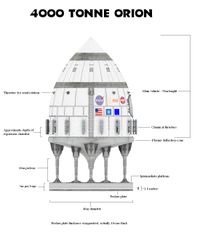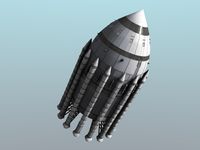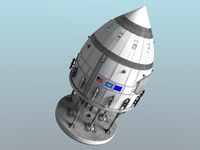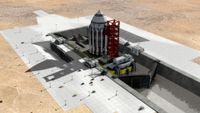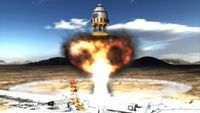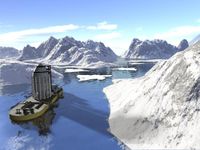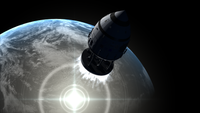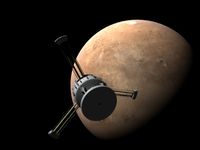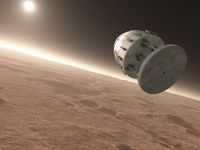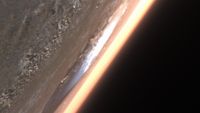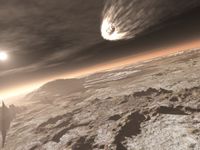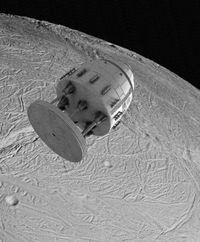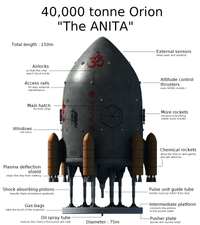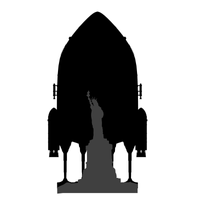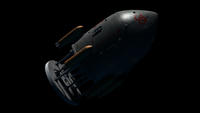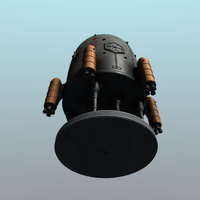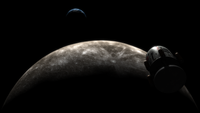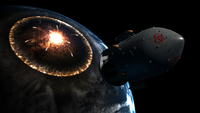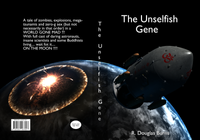Re-imagining Orion
To Mars and Beyond
This is the original version of the Orion nuclear spacecraft, with minor updates to make the thing more palatable – principally propelling it to high altitude using rockets before detonating the nuclear bombs. This avoids the great majority of the fallout, which is created at ground level by irradiating dust. It would certainly have been no worse than all the above-ground tests which happened anyway : not great, but not the everyone-will-die-instantly-of-radiation-poisoning that the more staunchly anti-nuclear campaigners sometimes portray.
The other change was extended arms to provide the astronauts with centrifugal habitats, at large enough distances to provide slow rotation for near-Earth gravity without everyone getting dizzy. I chose to show the intermediate 4,000 tonne Orion and my undergraduate project focused on whether this would be large enough to start a colony on Mars. If I remember correctly the answer was yes, but only just about. You probably couldn't start a permanent, fully self-sustaining colony (at least not one that would be a nice place to live), but you'd get surprisingly close.
Over the years I've seen some weird and wonderful anti-colony claims. None of them make any sense to me. I don't think this would be an especially difficult project except logistically; all you really need to solve the problem is lots and lots of mass. And Orion is ideal for this. So here I show it flying off to and landing on Mars. The landing is definitely the weakest point here, as it is in general for Orion-drive ships. I didn't do any calculations as to how much aerobraking (as shown) would help, and I don't remember how much rockets propellant would be needed to slow the final landing (though I think it's not too much). There'd also need to be something to ensure a stable landing : that pusher plate is really quite thin, so probably trying to balance a still more than a thousand tonnes of ship on top of it wouldn't be a good idea.
Many more details of this project can be found on my blog.
I later rendered a short clip from the animation in full HD. In the original video, you see the plasma from the bomb moving very slowly. This was a deliberate choice to ignore reality because I wanted to show how the matter from the explosion was directed, not just thrown spherically outwards. In the HD clip (and subsequent Orion renders) I used a more realistic appearance of a flash from the bomb and a flash on the pusher plate, with nothing else visible. But this directed-matter capability was important to the design, and it helped me in giving my final project presentation at the end of university course.
Stills from the project are shown below.
Bonus Content : The Unselfish Gene
Many years after the original renders, I was commissioned by author Robert Burns to make the cover image for his novel The Unselfish Gene. In the novel (which I've never read), humans on Earth are largely wiped out by a plague with only a few survivors left in a zombie-like state. Fortunately a lunar colony survives, but, lacking the supply of materials from Earth, throws its resources into construction of the Anita, a 40,000 tonne Orion-drive spacecraft. It's a race against time (presumably) for the colonists to reach Earth before a massive planet-killing comet comes along to finish the job. Well, how could I resist ?
You can buy the book here. I find it insultingly hilarious that one of the reviews says, "This book really deserves a better cover (so don't let that deter you from buying it)." I made a few concept shots besides the main cover, all of which you can see below.
